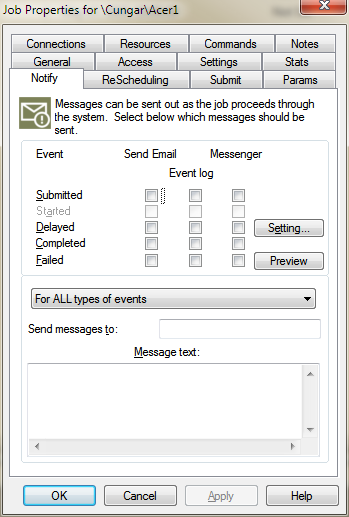Notifications can be set for a variety of events for a job as it proceeds through the system.
To set the notification events for jobs in EnterpriseSCHEDULE:
Click on the Notify tab in the Properties window.
There are six types of events that trigger notification processing. Select the event type and the notification type by selecting the appropriate check boxes. The events are listed below:
Event |
Description |
Event |
Description |
SUBMITTED |
job was submitted for execution |
STARTED |
job has started execution in the batch queue (VMS Only) |
DELAYED |
job is currently behind schedule |
COMPLETED |
job has completed execution |
FAILED |
job execution has failed |
Notifications may be sent via E-mail, Windows Event Log (Windows jobs only) or to a Windows Messenger window. Check off the desired type of notification (E-mail, Event Log or Messenger) for each type of event. You may select either, both or neither type of notification.

The notify section may contain preprocessor directives that will be filled in at runtime. Click on the Preview button to display the notes with all preprocessor directives interpreted.
In addition, these custom strings can be added to the notification list that control the way notifications are processed.
Note:
The keywords below must be entered in all capital letters for the notification option to work correctly.
String |
Description |
EMAIL="address<,address>" |
allows specification of additional e-mail addresses to send mail messages to. The list can be comma separated, or you can add multiple EMAIL= lines in the file. |
BROADCAST="user<,user>" |
allows specification of additional user opcoms/net sends/terminal messages. The list can be comma separated, or you can add multiple BROADCAST= lines in the file. MESSENGER= can be used as well. |
MAIL_SUBJECT="subject" |
allows the user to customize the mail message subject. They can incorporate environment variables into the control string. The user would need to look at the notify script for a full list of the environment variables defined. The environment variables referenced in the MAIL_SUBJECT must be in the format required. |
SEND_LOG |
available for completed and failed events, and simply appends the most recent log file to the end of the mail message. It is ignored for other event types. |
ATTACHMENT=<file path of attachment> |
An ASCII (text) file file will be attached using the path and file designation. ATTACHMENT_A and ATTACHMENT_M can be used to add additional text files on HP-UX, Solaris, Linux and AIX servers only. Example: ATTACHMENT=c:\temp\myfile.txt |
ATTACHMENT_B=<file path of attachment>
|
A binary file (executable, gif file, data file etc) will be attached using the path and file designation on Windows, HP-UX, Solaris, Linux and AIX servers only. ATTACHMENT_U can be used to add additional binary files onHP-UX, Solaris, Linux and AIX servers only. Example: ATTACHMENT_B=c:\temp\myfile.exe |
SENDER_DESCRIPTION=
|
Changes the "from" name when the email is received. |
SEND_SNMP(=message text~target_machine~severity) ! Optional parms
|
The SEND_SNMP option formats and sends a message to HP-OpenView via an SNMP trap. You can supply an optional target node, a specific HP-OV severity code to replace the default and additional text to display. To omit any items precede by leading ~ characters as necessary. |
SEND_HPOV(=message text~severity) ! Optional parms
|
The SEND_HPOV option formats and sends a message to HP-OpenView via the OPCMSG utility. You can supply a specific severity code to replace the default and additional text to display. To include only the additional text, precede by a leading ~ |
DO_NOT_SEND_MAIL
|
The DO_NOT_SEND_MAIL option allows for actions to be specified in the message section and mail notification to be be turned on but no mail is sent. Example: DO_NOT_SEND_MAIL |
DO_NOT_SEND_TO_SUBMIT_USER
|
The DO_NOT_SEND_TO_SUBMIT_USER option prevents the job from being sent to the username used to submit the job.This is the name listed under the submit attributes of the job. |
NO_HEADER
|
The Job Header including the Job Name, current time and set id is excluded from the notification. Example: NO_HEADER |
NO_JOB_STATS
|
The Job Statistics including Start and finished time and elapsed time is excluded from the job. |
HTML_FORMAT
|
Send email in formatted HTML. This is the default and does not need to be designated explicitely (EnterpriseSCHEDULE 7.5 and later only) Example: HTML_FORMAT
|
TEXT_FORMAT
|
Send email in plain Text format. This must be designated to bypass the HTML format defalt(EnterpriseSCHEDULE 7.5 and later only) Example: TEXT_FORMAT |
INCLUDE="text" |
Include the Notifications section of another job. Designate the path and name of the job. Example: INCLUDE= \jobs\master_job |
You may also set a e-mail address and message text for each type of event. The event types are selected from a drop down menu.
To set the e-mail and Message text settings for notifications: